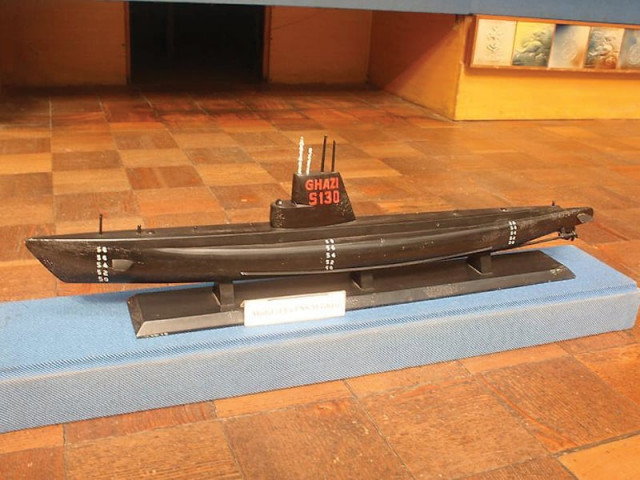
A sailor on duty explained to me that it was a reference to PNS Ghazi, a Pakistan Navy submarine that had disappeared with all its men on board. Although the Pakistan Navy had named them Ghazi, fate put them on the higher pedestal of Shaheed. I went through row upon row of names, each of which represented a life cut short by war, a family denied another chance to share its joys and sorrows, the names of men who left home on a mission for the motherland and never returned.
Forty years have gone by since those 93 brave men, including their leader Commander Zafar Muhammad Khan, died as the submarine sank in the Bay of Bengal, off the Visakhapatnam coast, under mysterious circumstances at the onset of the 1971 war.
The PNS Ghazi was originally the USS Diablo, a long-range Tench class submarine commissioned by the US Navy on March 31, 1945. It served the US Navy mainly on the Atlantic side and the Caribbean Sea until it was de-commissioned on June 1, 1964, and transferred to Pakistan under an agreement. For their brilliant performance in the 1965 war, the submarine won 10 awards, including two Sitara-e-Jurat decorations.
On November 14, 1971, PNS Ghazi sailed out of Karachi harbour on a seemingly impossible mission. It was to sail past the Western Indian defences, south along enemy shores to loop around Sri Lanka and then head North to the Bay of Bengal more than 3,000 miles away from its home base.
It will forever remain a mystery exactly what objectives were contained in its Top Secret brief, to be opened only mid-mission, when the craft was deep behind enemy lines. Tempting Indian naval assets in the region, such as the aircraft carrier Vikrant, could have been on its target list. After completing its mission, the Ghazi was supposed to report to Chittagong. The then East Pakistani ports, neglected under the specious doctrine of “the defence of the East lies in the West”, were hardly even capable of handling a grand boat like the Ghazi and it’s also possible that the Ghazi was to augment the Eastern naval forces, which comprised of little more than gun boats and a few riverine crafts.
With its 11,000-mile range, designed for the Atlantic and Pacific oceans, and the surprise and stealth factor of a submarine, the Ghazi was the only vessel capable of confronting the enemy in its own lair. The Ghazi reached Visakhapatnam, the headquarters of India’s Eastern Naval command, and proceeded to mine the entrance channel of the port. Had the Ghazi been able to complete this task, the entire Indian Eastern Naval fleet would have been bottled up in their own port. But that was not to be.
The answer to “What happened next?” depends largely upon where you search for it. Histories written on both sides of the border are likely to serve perceived national interests more than they serve the cause of accuracy.
GM Hiranandani, a retired vice admiral of the Indian Navy, writes in his book Transition to Triumph that the Ghazi was lured by reports indicating the presence of the Vikrant, which was actually stationed far away in safety.
Once the Ghazi took the bait, depth charges were dropped on the orders of Lt-Commander Inder Singh, the captain of the Indian destroyer INS Rajput, as the Ghazi exited the port’s channel. This resulted in the sinking of the Ghazi and Lt-Commander Singh was later decorated with the Indian gallantry award Vir Chakra.
The Pakistani version, as laid out by the Directorate of Public Relations — Pakistan Navy, is that probably due to high currents in the Bay of Bengal, the Ghazi hit a mine that it had laid down itself. Whatever the truth, the incident marked the first time a submarine sank during a war after the Second World War.
Interestingly, the Indian Government turned down requests by the US and the then-USSR to raise the submerged sub from the sea. In 2010, all records related to the sinking of the Ghazi were also reported to have been destroyed by the Indian Navy. Lt General (retd) JFR Jacob, who served as the chief of staff of the Indian Army’s Eastern Command during the 1971 war, suggested in a May 2010 article that the Ghazi had met an accidental end and the Indian Navy had nothing to do with its sinking, hence the destruction of the records. Many other heavyweights on the Indian side also share this scepticism of the Indian Navy’s official stance.
To gain an independent opinion, I got in touch with the veteran USS Diablo crew who had served on the boat before it became PNS Ghazi. They had studied sonar pictures and sketches of the sunken vessel and believed that an explosion in the Forward Torpedo Room (FTR) destroyed the Ghazi. This view is also shared by Indian journalist Sandeep Unnithan, who specialises in military and strategic analysis.
Underwater video footage obtained by divers also shows jagged portions of the FTR jutting outwards, adding credence to the internal explosion theory.
Hours after the Indian government officially announced the sinking of the Ghazi on December 9, 1971 (almost ten days after the actual event), a Pakistani submarine PNS Hangor engaged in a death-defying duel with two anti-submarine vessels of the Indian navy which were sent to find and destroy it. Hangor, literally meaning “Shark” in Bengali, certainly had a bite worth its nickname. It not only managed to evade its hunters, it also sunk the INS Khukri and damaged the INS Kirpan. This was the first time after World War II that a submarine claimed a confirmed kill.
A few days after the Ghazi’s destruction, Indian divers opened up the vessel and entered it to recover whatever valuable information they could. They salvaged some objects, a few of which are displayed at an Indian war-time museum nearby. Unnithan wrote that the divers also came across some bodies, among them a sailor who “had in his pocket a poignant letter written in Urdu to his fiancé: ‘I do not know if you will ever read this, but we are here separated by thousands of miles of sea...’”
Forty years later, as I stood in a museum those very thousands of miles away, I wondered which sailor it was among these countless names who had written the letter.
Those men wrote a tale of bravery across the waters of the Indian Ocean and paid the highest price for it. Even four decades on, their courage and efforts must not be forgotten.
Their last resting place reminds me of Rupert Brooke, an English poet who volunteered for service in the navy during the First World War and wrote a poem titled “The Soldier”:
If I should die, think only this of me:
That there’s some corner of a foreign field
That is forever England. There shall be
In that rich earth, a richer dust concealed;
Rupert Brooke died on duty and was buried in Greece — a foreign land. The poem would be a fitting tribute to the 93 Pakistanis who, like Brooke, died on another land while serving their own.
Published in The Express Tribune, Sunday Magazine, May 27th, 2012.












1732012115-0/Untitled-design-(14)1732012115-0-270x192.webp)






COMMENTS
Comments are moderated and generally will be posted if they are on-topic and not abusive.
For more information, please see our Comments FAQ